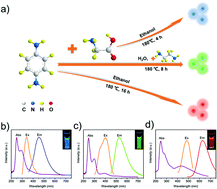Full color carbon dots through surface engineering for constructing white light-emitting diodes†
Abstract
White light-emitting diode (WLED) devices are replacing the filament lamp and can provide a light close to natural sunlight, and they have thus drawn considerable attention in recent years. It remains a scientific challenge to develop WLEDs using environmentally friendly, easy-to-process and cost-effective phosphors. Here we synthesized blue-, green- and red-carbon dots (denoted as B-, G- and R-CDs) by a facile solvothermal method with high dispersity both in an aqueous and organic solvent. The quantum yield (QY) of the R-CDs was up to 24.7%. These CDs can be easily dissolved in polyvinylpyrrolidone (PVP) colloid, leading to the production of ultraviolet (UV)-excited LED devices to avoid the retinal damage caused by blue ray excitation. The fluorescence emission of the WLED has a wide band, covering the whole visible light region. Importantly, the influence of doping that gives rise to the change of emissive colors has been elucidated by X-ray photoelectron spectroscopy (XPS) combined with a computational method in order to provide a systematic controllable tuning on the functionalization of CDs. As such, WLEDs were demonstrated with color coordinates of (0.33, 0.33), and a color temperature of 5612 K in the CIE chromaticity diagram with good anti-photobleaching and a color rendering index (CRI) of 89.



 Please wait while we load your content...
Please wait while we load your content...
